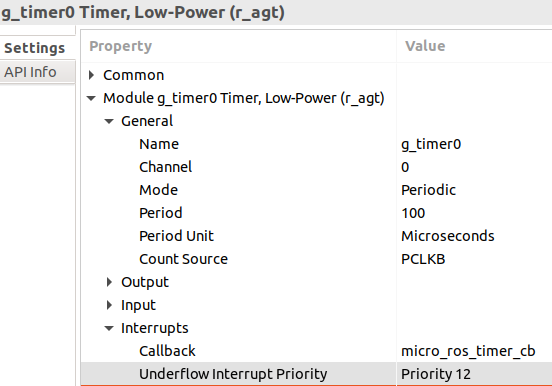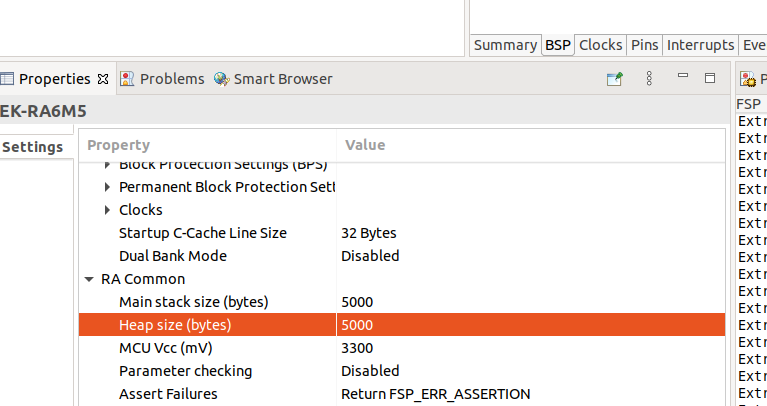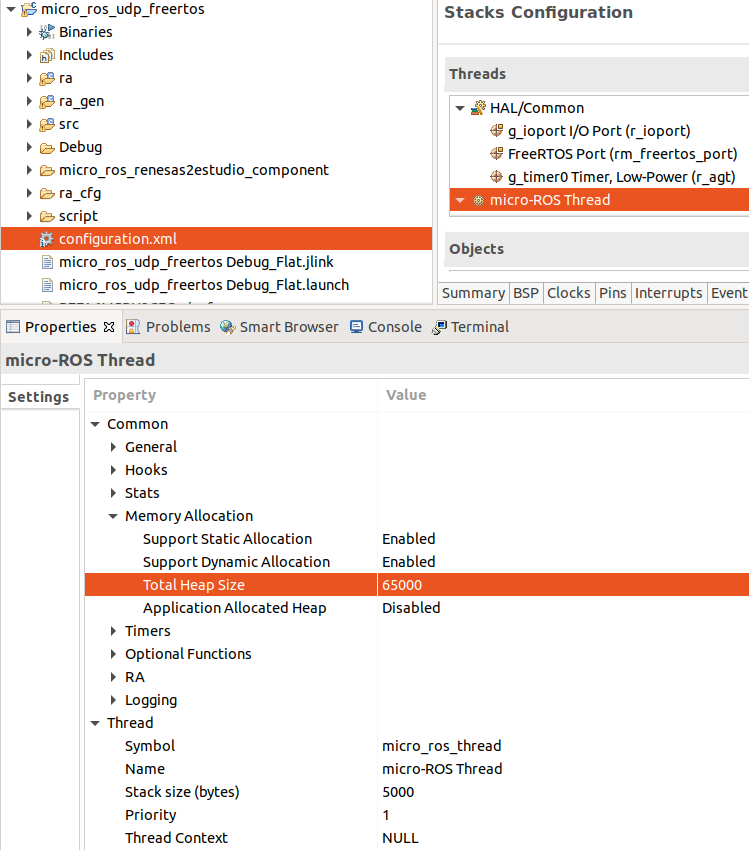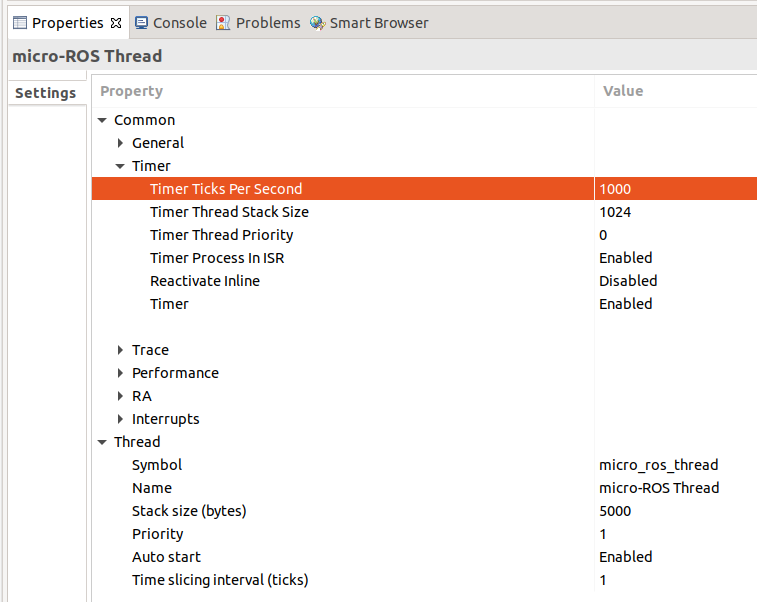This package eases the integration of micro-ROS in a Renesas e2 studio. This components targets Renesas RA family, an ARM Cortex-M based MCU series, enabling a full micro-ROS compatibility for developing robotics and IoT applications.
| MCU | Family | Reference board | Transports |
|---|---|---|---|
| RA6M5 | RA Series | EK-RA6M5 | USB-CDC Serial UART UDP (FreeRTOS + TCP) UDP (ThreadX + NetX) TCP (AWS Secure Sockets) CAN FD |
| RA6T2 | RA Series | MCK-RA6T2 | Serial UART CAN FD |
- Renesas e2 studio for Linux1
- FSP v4.4.0 board packs for Renesas e2 studio: Details.
- GNU Arm Embedded Toolchain v10.3.1.20210824 (Other compatible toolchain may work).
- Install
rsync:apt -y install rsync - Install colcon and dependencies, for example with:
pip3 install colcon-common-extensions catkin_pkg lark-parser empy1 Currently only support for Linux is available
A ready-to-use example of this component can be found in micro-ROS demos for Renesas e2 studio repo.
It is possible to use a micro-ROS Agent just by using this docker command:
# UDPv4 micro-ROS Agent
docker run -it --rm -v /dev:/dev -v /dev/shm:/dev/shm --privileged --net=host microros/micro-ros-agent:$ROS_DISTRO udp4 --port 8888 -v6
# TCPv4 micro-ROS Agent
docker run -it --rm -v /dev:/dev -v /dev/shm:/dev/shm --privileged --net=host microros/micro-ros-agent:$ROS_DISTRO tcp4 --port 8888 -v6
# Serial micro-ROS Agent
docker run -it --rm -v /dev:/dev -v /dev/shm:/dev/shm --privileged --net=host microros/micro-ros-agent:$ROS_DISTRO serial --dev [YOUR BOARD PORT] -v6
# CAN-FD micro-ROS Agent
docker run -it --rm -v /dev:/dev -v /dev/shm:/dev/shm --privileged --net=host microros/micro-ros-agent:$ROS_DISTRO canfd --dev [YOUR CAN INTERFACE] -v6There are some other options for using the micro-ROS Agent:
- Building it in a ROS 2 environment: Details.
- Using a snap package.
micro-ROS can be integrated with a Renesas e2 studio project following these steps:
-
Clone this repository in your Renesas e2 studio project folder.
-
Go to
Project -> Properties -> C/C++ Build -> Settings -> Build Steps Taband inPre-build stepsadd:
cd ../micro_ros_renesas2estudio_component/library_generation && ./library_generation.sh "${cross_toolchain_flags}"-
Add micro-ROS include directory.
Steps
In
Project -> Settings -> C/C++ Build -> Settings -> Tool Settings Tab -> GNU ARM Cross C Compiler -> Includes- add
"${workspace_loc:/${ProjName}/micro_ros_renesas2estudio_component/libmicroros/include}"inInclude paths (-l)
- add
-
Add the micro-ROS precompiled library.
Steps
In
Project -> Settings -> C/C++ Build -> Settings -> Tool Settings Tab -> GNU ARM Cross C Linker -> Libraries- add
"${workspace_loc:/${ProjName}/micro_ros_renesas2estudio_component/libmicroros}"inLibrary search path (-L) - add
microrosinLibraries (-l)
- add
-
Add the following source code files to your project, dragging them to source folder.
extra_sources/microros_time.cextra_sources/microros_allocators.cextra_sources/microros_allocators.hextra_sources/microros_transports.h
-
Configure micro-ROS time reference.
Steps
Configure
g_timer0as anr_agt-
Double click on the
configuration.xmlfile of your project and go to theStackstab. -
Select
New Stack -> Driver -> Timers -> Timer, Low-Power (r_agt). -
Modify the clock period on the component properties (
Module g_timer0 Timer, Low-Power (r_agt) -> General -> Period) to100 -
Modify the clock period unit on the component properties (
Module g_timer0 Timer, Low-Power (r_agt) -> General -> Period Unit) toMicroseconds -
Modify the count source on the component properties (
Module g_timer0 Timer, Low-Power (r_agt) -> General -> Count Source) toPCLKB -
Modify the interrupt callback on the component properties (
Module g_timer0 Timer, Low-Power (r_agt) -> Interrupt -> Callback) tomicro_ros_timer_cb -
Modify the underflow interrupt priority on the component properties (
Module g_timer0 Timer, Low-Power (r_agt) -> Interrupt -> Underflow Interrupt Priority) toPriority 12 -
Save the modifications by clicking on
Generate Project Content.
-
-
Configure micro-ROS memory requirements.
Bare Metal
Configure the stack and heap size:
FreeRTOS
Create and configure the micro-ROS FreeRTOS task:
-
On the
configuration.xmlmenu, go to theStackstab and create a new thread for micro-ROS. -
Click on the created thread, then select
New Stack -> RTOS -> FreeRTOS Heap 4. -
Configure the micro-ROS thread properties:
- Set the name of the thread entry function under
Thread -> Symboltomicro_ros_thread. - Set
Thread -> Stack size (bytes)to 5000 B. - Set
Common -> Memory Allocation -> Support Dynamic AllocationtoEnable. - Set
Common -> Memory Allocation -> Support Static AllocationtoEnable. - Set
Common -> Memory Allocation -> Total Heap Sizeto 65000 B.
- Set the name of the thread entry function under
-
On the
configuration.xmlmenu, go to theBSPtab. -
Go to the
RA Commonsection and set theMain stack size (bytes)andHeap size (bytes)fields to 5000 B:Note: It is required to have some heap outside FreeRTOS heap because newlib will use it
-
Save the modifications clicking on
Generate Project Content. -
Check that the file
thread_microros_entry.chas been created on the project source directory.
ThreadX
Create and configure the micro-ROS ThreadX thread:
-
On the
configuration.xmlmenu, go to theStackstab and create a new thread for micro-ROS. -
Configure the micro-ROS thread properties:
- Set the name of the thread entry function under
Thread -> Symboltomicro_ros_thread. - Set and the thread stack size
Thread -> Stack size (bytes)to 5000 B. - Increase thread timer resolution
Common -> Timer -> Timer Ticks Per Secondto 1000 ticks per second.
- Set the name of the thread entry function under
-
On the
configuration.xmlmenu, go to theBSPtab. -
Go to the
RA Commonsection and set theMain stack size (bytes)andHeap size (bytes)fields to 5000 B: -
Save the modifications by clicking on
Generate Project Content. -
Check that the file
thread_microros_entry.chas been created on the project source directory.
-
-
Configure the micro-ROS transports: Details.
-
Add micro-ROS code in your codebase.
-
Build and run your project.
In order to include a custom package in the micro-ROS build, just copy the package folder into library_generation/extra_packages folder. The build system will automatically detect the package and build it along with the micro-ROS library.
Note that a library rebuild is needed to include the package, this can be achieved by deleting the libmicroros generated folder and building your project afterwards.
This repository is open-sourced under the Apache-2.0 license. See the LICENSE file for details.
For a list of other open-source components included in this repository, see the file 3rd-party-licenses.txt.
There are no known limitations.





